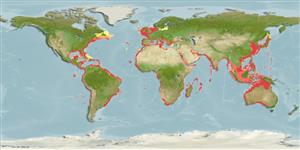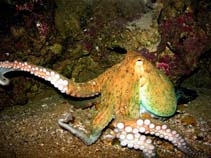Octopus vulgaris Cuvier, 1797
Common octopus| Native range | All suitable habitat | Point map | Year 2050 |

|
| This map was computer-generated and has not yet been reviewed. |
| Octopus vulgaris AquaMaps Data sources: GBIF OBIS |
Classification / Names Common names | Synonyms | CoL | ITIS | WoRMS
Cephalopoda | Octopoda | Octopodidae
Environment: milieu / climate zone / depth range / distribution range Ecology
Reef-associated; oceanodromous (Ref. 75927); depth range 0 - 347 m (Ref. 417), usually 0 - 100 m (Ref. 1977). Tropical; ? - 7°C (Ref. 275), preferred 26°C (Ref. 107945); 57°N - 38°S, 98°W - 146°E (Ref. 275)
Distribution Countries | FAO areas | Ecosystems | Occurrences | Introductions
Circumglobal in temperate and tropical seas.
Length at first maturity / Size / Weight / Age
Maturity: Lm ?, range 8 - 11.3 cm Max length : 180 cm TL male/unsexed; (Ref. 104052); 120 cm TL (female); max. published weight: 10.0 kg (Ref. 275)
Maximum common depth is 150 m in Ref. 75927. Maximum depth range from Ref. 114857. Maximum length for female from Ref. 804. This octopus is taken by amateur fishers and in small to large-scale harvest throughout its range. The greatest fishery effort occurs off northwest Africa, and it is know as one of the most valuable octopod species throughout the Mediterranean Sea where it is marketed fresh or frozen (Ref. 96968).
Life cycle and mating behavior Maturity | Reproduction | Spawning | Eggs | Fecundity | Larvae
Members of the class Cephalopoda are gonochoric. Male and female adults usually die shortly after spawning and brooding, respectively. Mating behavior: Males perform various displays to attract potential females for copulation. During copulation, male grasp the female and inserts the hectocotylus into the female's mantle cavity where fertilization usually occurs. Life cycle: Embryos hatch into planktonic stage and live for some time before they grow larger and take up a benthic existence as adults.
Main reference
References | Coordinator | Collaborators
Roper, C.F.E., M.J. Sweeney and C.E. Nauen. 1984. (Ref. 275)
IUCN Red List Status (Ref. 130435: Version 2024-1)
Least Concern (LC) ; Date assessed: 08 April 2016
CITES status (Ref. 108899)
Not Evaluated
CMS (Ref. 116361)
Not Evaluated
Threat to humans
Human uses
Fisheries: commercial
FAO - Fisheries: landings, species profile | FIRMS (Stock assessments) | FishSource | Sea Around Us
Tools
More information
Trophic Ecology
Ecology
Population dynamics
Life cycle
Distribution
Human Related
Aquaculture profile
Stamps, Coins Misc.
Stamps, Coins Misc.
Outreach
Taxonomy
References
Internet sources
BHL | BOLD Systems | CISTI | DiscoverLife | FAO(Fisheries: species profile; publication : search) | Fishipedia | GenBank (genome, nucleotide) | GloBI | Gomexsi | Google Books | Google Scholar | Google | PubMed | Tree of Life | Wikipedia (Go, Search) | Zoological Record
Estimates based on models
Preferred temperature
(Ref. 115969): 10 - 28.9, mean 25.8 (based on 8514 cells).
Resilience
(Ref. 69278):
High, minimum population doubling time less than 15 months (K=0.38-0.72; tm=1.2).
Prior r = 0.77, 95% CL = 0.51 - 1.15, Based on 4 full stock assessments.
Nutrients : Calcium = 126 [75, 177] mg/100g; Iron = 4.79 [1.67, 7.92] mg/100g; Protein = 15.5 [13.7, 17.4] %; Omega3 = 0.414 [0.262, 0.566] g/100g; Selenium = 57.8 [48.5, 67.2] μg/100g; VitaminA = 0 μg/100g; Zinc = 1.97 [0.92, 3.02] mg/100g (wet weight); based on nutrient studies.



